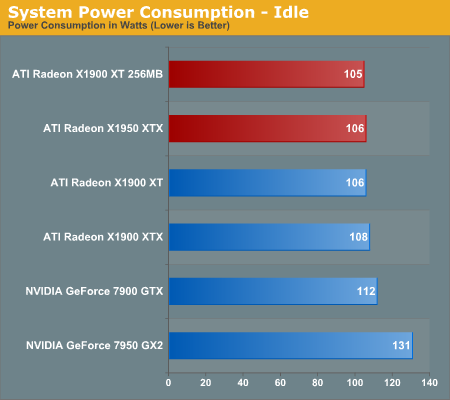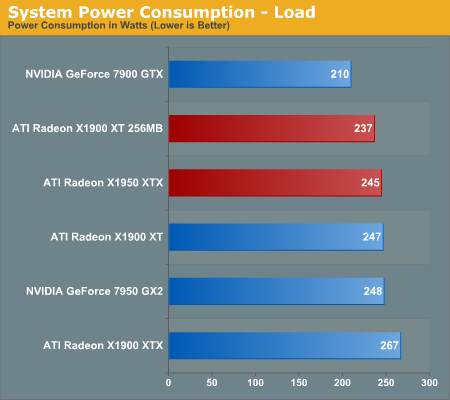ATI's New High End and Mid Range: Radeon X1950 XTX & X1900 XT 256MB
by Derek Wilson on August 23, 2006 9:52 AM EST- Posted in
- GPUs
Power to the People
The major power hog of this generation is the X1900 XTX, as we have made clear in past articles. Almost disturbingly, a single X1900 XTX draws more power than a 7950 GX2, and X1900 XTX CrossFire is more power hungry than 7950 Quad SLI. While ATI already had the slightly lower clocked X1900 XT available for those who wanted something that acted slightly less as a space heater, they needed something that performed better and fit into the same (or better) power envelope to round out this generation of GPUs for them. What they latched on to has now given graphics cards sporting the R580+ a much needed drop in power: GDDR4.
As we explained in the GDDR4 section, the optimizations made to this generation of graphics memory technology have been designed with both power savings and potential speed in mind. We've already seen how the higher speed memory pulls through in our performance tests, but how does it hold up on the power front?
For this test, used our Kill-A-Watt to measure system power at the wall. Our load numbers are recorded as maximum power draw during a run of 3DMark06's fill rate and pixel shader feature tests.


Apparently, JEDEC and ATI did their jobs well when deciding on the features of GDDR4 and making the decision to adopt it so quickly. Not only has ATI been able to improve performance with their X1950 XTX, but they've been able to do so using significantly less power. While the X1950 XTX is still no where near the envelope of the 7900 GTX, drawing the same amount of power as the X1900 XT and 7950 GX2 is a great start.
It will certainly be interesting to see what graphics makers can do with this RAM when focusing on low power implementations like silent or budget products.










74 Comments
View All Comments
JarredWalton - Wednesday, August 23, 2006 - link
We used factory overclocked 7900 GT cards that are widely available. These are basically guaranteed overclocks for about $20 more. There are no factory overclocked ATI cards around, but realistically don't expect overclocking to get more than 5% more performance on ATI hardware.The X1900 XTX is clocked at 650 MHz, which isn't much higher than the 625 MHz of the XT cards. Given that ATI just released a lower power card but kept the clock speed at 650 MHz, it's pretty clear that there GPUs are close to topped out. The RAM might have a bit more headroom, but memory bandwidth already appears to be less of a concern, as the X1950 isn't tremendously faster than the X1900.
yyrkoon - Wednesday, August 23, 2006 - link
I think its obvious why ATI is selling thier cards for less now, and that reason is alot of 'tech savy' users, are waiting for Direct3D 10 to be released, and want to buy a capable card. This is probably to try an entice some people into buying technology that will be 'obsolete', when Direct3D 10 is released.Supposedly Vista will ship with Directx 9L, and Directx 10 (Direct3D 10), but I've also read to the contrary, and that Direct3D 10 wont be released until after Vista ships (sometime). Personally, I couldnt think of a better time to buy hardware, but alot of people think that waiting, and just paying through the nose for a Video card later, is going to save them money. *shrug*
Broken - Wednesday, August 23, 2006 - link
In this review, the test bed was an Intel D975XBX (LGA-775). I thought this was an ATI Crossfire only board and could not run two Nvidia cards in SLI. Are there hacked drivers that allow this, and if so, is there any penalty? Also, I see that this board is dual 8x pci-e and not dual 16x... at high resolutions, could this be a limiting factor, or is that not for another year?DerekWilson - Wednesday, August 23, 2006 - link
Sorry about the confusion there. We actually used an nForce4 Intel x16 board for the NVIDIA SLI tests. Unfortunately, it is still not possible to run SLI on an Intel motherboard. Our test section has been updated with the appropriate information.Thanks for pointing this out.
Derek Wilson
ElFenix - Wednesday, August 23, 2006 - link
as we all should know by now, Nvidia's default driver quality setting is lower than ATi's, and makes a significant difference in the framerate when you use the driver settings to match the quality settings. your "The Test" page does not indicate that you changed the driver quality settings to match.DerekWilson - Wednesday, August 23, 2006 - link
Drivers were run with default quality settings.Default driver settings between ATI and NVIDIA are generally comparable from an image quality stand point unless shimmering or banding is noticed due to trilinear/anisotropic optimizations. None of the games we tested displayed any such issues during our testing.
At the same time, during our Quad SLI followup we would like to include a series of tests run at the highest possible quality settings for both ATI and NVIDIA -- which would put ATI ahead of NVIDIA in terms of Anisotropic filtering or in chuck patch cases and NVIDIA ahead of ATI in terms of adaptive/transparency AA (which is actually degraded by their gamma correction).
If you have any suggestions on different settings to compare, we are more than willing to run some tests and see what happens.
Thanks,
Derek Wilson
ElFenix - Wednesday, August 23, 2006 - link
could you run each card with the quality slider turned all the way up, please? i believe that the the default setting for ATi, and the 'High Quality' setting for nvidia. someone correct me if i'm wrong.thanks!
michael
yyrkoon - Wednesday, August 23, 2006 - link
I think as long as all settings from both offerings are as close as possible per benchmark, there is no real gripe.Although, some people seem to think it nessisary to run AA as high resolutions (1600x1200 +), but I'm not one of them. Its very hard for me to notice jaggies even at 1440x900, especially when concentrating on the game, instead of standing still, and looking with a magnifying glass for jaggies . . .
mostlyprudent - Wednesday, August 23, 2006 - link
When are we going to see a good number of Core 2 Duo motherboards that support Crossfire? The fact that AT is using an Intel made board rather than a "true enthusiast" board says something about the current state of Core 2 Duo motherboards.DerekWilson - Wednesday, August 23, 2006 - link
Intel's boards are actually very good. The only reason we haven't been using them in our tests (aside from a lack of SLI support) is that we have not been recommending Intel processors for the past couple years. Core 2 Duo makes Intel CPUs worth having, and you definitely won't go wrong with a good Intel motherboard.